Akira Shimizu - Beauty and Scissors


Beauty and Scissors
1960's -
Color pencis, paper
79.2(H) x 54.5(W) (cm)
In this composition, the scissors is personified as a woman. The contrast of scissors and the moon is exotic and the symmetry between the kimono and the scissors makes for fantastic harmony.
The red thread at the end of the scissors may remind some Japanese people of an old Chinese legend which says, "the little fingers of a man and a woman who will marry in the future are connected by a red thread."
In this drawing, the scissors is seemingly in love with the moon. However, because love between the moon and the scissors is forbidden, it looks as if she (the scissors) is going to attempt something insane with her blade.
One of Shimizu’s favorite motifs is women’s emotion or passion for love.
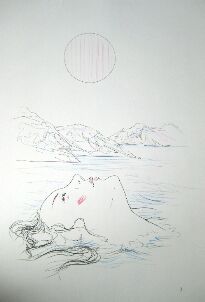
Jerry Fish
1960's -
Color pencils, paper
79.2(H) x 54.5(W) (cm)
In the Chinese character, the Jerry fish is written as 水母, meaning “mother of water” or 海月, "moon of ocean". It appeared in Kojiki, the oldest existing chronicle in Japan, dating from the early 8th century, and supposedly since then, it has been an attractive living creature that has influenced the Japanese mind.
As its Chinese characters explain, the jerry fish floating in the water looks like a moon. Since Shimizu has named his work “Jerry Fish”, a creature whose body is filled with gelatin, we might conclude that the woman’s body is also filled with gelatin. It is left to the observer to determine the mood of the woman and what she might be experiencing.
(MK)
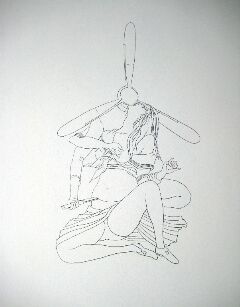
Spring Note
1960's -
Color pencils, paper
79.2(H) x 54.5(W) (cm)
A woman who kisses a man with a head of a “Zero-Fighter” is going to be killed by him with a sword. The Zero-fighter was a long range fighter aircraft operated by Japanese Air Service from 1940 to 1945. A personified symbol of World War II and an intoxicated woman are depicted here. This monochrome work, producing a decadent and self-intoxicated atmosphere, would remind the Japanese people of “Seppuku”, a form of ritual suicide by the sword practiced mainly by samurai (military nobility of pre-industrial Japan) from the 12th to the late 19th century. It symbolizes death with honor rather than falling into the hands of the enemy.
Shimizu said "when I was a boy I learned how to draw Zero-Fighters from one of my relatives, a young man living with me in those days, who was very good at drawing Japanese fighter aircrafts." It was in the midst of Japanese Imperialism, and people were forced to engage in the "sacred war". Back then, Zero Fighters were heros in the eyes of many Japanese children. Although he did not talk much about this composition, it has various meanings including a farewell to the militarism and the liberation from it.
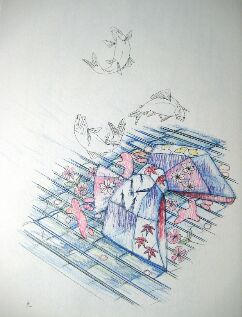
Wier
1960's -
Color pencis, paper
79.2(H) x 54.5(W) (cm)
Japanese weir is a small dam, built in a stream or river, in order to catch fish. By partially damming up the flow of the river, the narrowed stream produces rapidness. Defeated by the speed of the flow, fish falls on the bamboo mat (spatula) of the weir. (This fishing is carried out only for sightseeing purpose today.)
The belt of a splendid kimono is put next to several sweetfish that jump up on the bamboo. A beautiful woman, who is an incarnation of a sweetfish that is caught right now, might have worn the belt. Losing the owner, only the belt is left lonesome. Under the sweetfish there are waterdrops on the bamboo mat, and they may be tears of them who regret the beauty of short lives.(MK)

Shadow Drop
1960's -
Color pencis, paper
79.2(H) x 54.5(W) (cm)
The woman with the Japanese coiffure, wearing clog on the face, might be Ninja, an errand of the moon. (The artist was once worked as a carpenter as a part-timer. In a stage of construction called Doma-Osae, where the surface of floor is smoothed, a pair of shoes called "Ninja" is worn. ) The errand of the moon strikes the crane and the turtle by the art of blowgun. The speed of the blowgun is fast enough to throw a shadow out, or, blow candlelight off. And the Ninja-art will bring the spectators to an exciting world full of thrill and mystery.
This picture reminds me of the old Japanese song, "Kagome Kagome" sung in the child games. The mysterious lyric says “a crane and a turtle slipped at dawn, guess who is right behind you?" That might be an incarnation of the moon, or a Ninja. Be careful, or you might be shot by blowgun of the moon or Ninja.
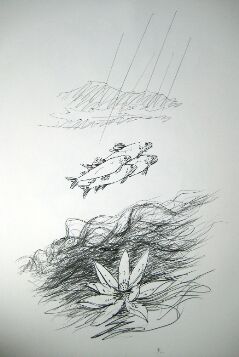
Sho River
1960's -
Color pencils, paper
79.2(H) x 54.5(W) (cm)
The work contains the sweetfish which lives in the Sho River that flows in the western part of Toyama, Mount Tate, the tallest peak of the Japanese Northern Alps, and woman's hair. A long time ago, the Sho River was called the Ogami River, which in Japanese literally means "male god river", and its origin dates back to the Ogami shrine located at the threshold of the valley.
Throughout history, the Sho River frequently caused floods. However, for many years, the snow and rain that fell into the Mount Tate Range has been indispensable to the residents near the river, the fish, and the animals. Therefore, the river has been worshiped and adored by the residents in the area.
Although its appearance has been changed dramatically by the modernization and repair work, there is no doubt that the artist wove nostalgia into this work.
(MK)
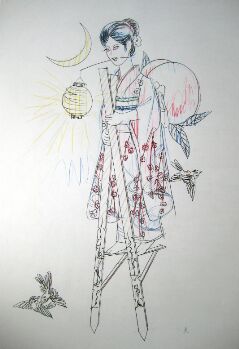
The Ida River
1960's -
Color pencils, paper
79.2(H) x 54.5(W) (cm)
Since Shimizu has named this work “The Ida River”, we can conclude that the young woman in the kimono is crossing the river on stilts under a crescent moon. She carries a large peach on her shoulder, which based on Japanese lore, is used as a charm to ward off devils. The Ida River flows through the Toyama prefecture, the author’s hometown, and was well-known for its frequent floods which for many years caused great suffering.
Her eyes seem to be closed, suggesting she is sleepwalking through the river. The young woman in the Kimono, the crescent, the Japanese stilts and the peach blend together in a surrealistic way, so that one can perceive the unconscious images the artist intended.
(MK)

Oyama
1960's -
Color pencils, paper
79.2(H) x 54.5(W) (cm)
Oyama is a main peak of Mount Tate, which is located in Toyama Prefecture or Northern Japanese Alps that is author's hometown. Mount Tate is worshiped as a god, and the god is enshrined in the small shrine at the top of the mountain. The appearance of Oyama, literally means Male Mountain in Japanese, is very magnificent. Depicted is a premarital girl in dignified beauty, with feeling of shy. She might pray for the safety of her lover in the Shinto shrine.
Above her is a "Bell of Shrine", a sound device made from electric bubs and Japanese scissors. (Usually bells in a shrine is made of copper or brass and supposed to make sound when the prayer shakes it. The meaning of this bell is to make the prayer pious, to purify the wicked mind, and draw the god to the place. ) Moreover, the cuckoo flies down and chirps against her, which gives her additional sound.
Is the sound played by scissors and bulbs harmonious enough to purify the mind of the girl? Or does it make unharmonious sound taking her to another world of "four-dimension"? Together with cuckoo, the gust of wind at early spring might be mischievous enough to make mysterious music, and the girl might dream between the line of reality and unreality.(MK)
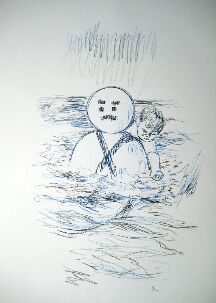
Towing
1960's -
Color Pencils, paper
79.2(H) x 54.5(W) (cm)
The snowman that carries a young boy and crosses over the ocean in the raging waves is the artist himself. According to him, as a boy he used to help making household income by collecting scrap pieces of metals that were left in the roads, and selling them. At that time he had to take care of two young brothers, so he carried his youngest brother on his back, and held the hand of his another brother while walking on the roads.
Every early winter, Buriokoshi, thunderstorm weather with strong wind comes to the ocean of Hokuriku Area that is hometown of the artist. (Buriokoshi literally means "bringing yellowtail", and after this bad weather, fishing season for yellowtail is supposed to come.) The artist, born and lived many years near the Hokuriku ocean area, may find himself in the image of a ship towing another one in the heavy ocean. (MK)
"Beauty and Scissors" series is, so to speak, a compilation of Shimizu's drawing, or his idea for the last 40 years. And the naming of this series originates from the artist’s basic philosophy to art. Art is knitted to a rope from opposite objects like the darkness and the light, life and death, substance and spirit. "The lope is one-way traffic as it is", but he "puts stakes on the rope, and it is strained to withstand any pressure." He adds, "this is artist's mission and I want you to walk on this rope as in the ropewalking".
He has been working on various techniques for the last 40 years, and concurrently making drawings on the papers with pencils. Inspired by various themes, his never-ending motifs are embodied on the papers, and next, composed to oil paintings, sculpture works and collages. Some of his ideas stay on the sketch papers because "they are better in the sketches", the artist says.
When you see the entire drawings, you may be surprised at diversity of writer's inspiration, such as mystique of woman, Butoh Dance, primitive memories from his childhood and, his hometown. They are not completed as only experienced principles, but the artist “sharpens the images and makes happening in each work.”
Woman's mysterious image
The mystique and devilishness of woman are expressed and symbolized by Beauty and scissors, as the name of this series shows. He may have had been special attachment to scissors from his childhood, because his mother used to make the household living by sewing kimono. Moreover, this type of scissors can be used for a long period by sharpening and handling carefully. The user may love it, as if it is part of his body. The artist overlaps women’s image on the scissors.
Image of Butoh Dance
Relations with Butoh Dance go back to the friendship with Tatsumi Hijikata, founder of Butoh, which started late 60’s. Deeply impressed by Hijikata’ s Butoh, Shimizu played his role in designing of costumes, commercial posters and sound effects. Hijikata was also influenced by Shimizu's inspiration, so was his wife, Hanako Motofuji. For instance, Motofuji performed Butoh Dance in which she cut a piece of cloth with scissors in her later years. The idea came from Shimizu’s idea originally, and according to Shimizu, Motofuji performed various dances based upon his ideas. Thus, Shimizu and Hijikata gave influences each other, and they shared the philosophy based on the recurrence of primitive part of human beings.
Image of hometown
Works inspired by nature of is hometown, Toyama are repeatedly seen in this series, they are Sho River, Ida River and Mount Oyama, etc. For instance Sho River, of which stream is flown from Mount Tate Range where lots of snow and rich rain fall, has been indispensable water source for the residents along the river.
Rain that pours down over the steep range flows to the plain, and enriches the fish, the animal, and people. However, due to the repair work and the construction of dams on the water systems, the number of sweetfish, carps, crucian carps, and loaches that live in the river decrease sharply. The artist overlaps opposite faces of woman with the image of the nature in hometown.
Image of infancy
Artworks Inspired by the memories in his boyhood, such as Towing and Baby-sitting Boat play important roles in this series. His love to his mother and the primitive experiences in his childhood are major inspirations. In his schooldays, Japan was in the midst of militarism. Under such circumstances, the artist's father died of sickness when he was an infant, and his mother had to earn the household living working in a spinning factory and sewing kimonos.
As an infant, the artist was taken to the baby-sitter room in the factory, but there were no full-time babysitter who took care of the infants. Absolutely different from the current nursery system, the artist says, he was bound to the pillar in the room, and waiting for his mother to come for breast-feeding at the recess time.
In his mind several scenes remains very clearly, he recalls. One of them is the scene in which several Japan imperial solders took all the food (rice) away, when they (his mother, grand mother and himself) carried it in a cart in heavy snow weather. In the midst of the WWII, people were starving, and it was right after they finally obtained their important food, he says.
After his mother married again, two younger brothers were born. He used to take care of them, carrying the youngest brother on his back, and holding the hand of the second brother. He sometimes collected scrap iron metals and sold it to a factory, in order to contribute to household income. He recalls the whiteness of his mother’s calves and hands, and overlaps with that of snow fallen in his hometown famous for heavy snow.(MK)

© 2008 Akira Shimizu. All rights reserved










